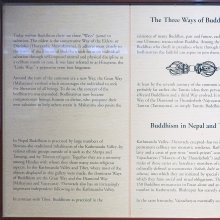Buddhism in nepal, Nepalese Buddhism: 1 definition
Introduction:
Buddhism in nepal means something in the history of ancient India. If you want to know the exact meaning, history, etymology or English translation of this term then check out the descriptions on this page. Add your comment or reference to a book if you want to contribute to this summary article.
Images (photo gallery)
India history and geography
Source: academia.edu: History of Nepalese Buddhism: From Mythological Tradition to the Lichhavi PeriodThe history of Buddhism of Nepal is basically of two types—(1) mythological and (2) documentary. The mythological narration pertaining to Buddhism is also regarded as very important supporting evidence for the study of Nepalese Buddhism. Although such narration deals with mythology as well as stories of the deeds and miraculous powers of Buddhist deities and the devotees, it is deeply rooted in the practical aspect of Nepalese Buddhist culture.
(1) The mythological sources of Buddhism in Nepal include narratives such as Svayambhu Purana, chronicles such as Bhasavamsavali, Gopalraj Vamsavali and other Vamsavalis, stories and accounts of the miraculous activities of the deities, the followers and so forth. [...] The accounts given in the Svayambhu Purana and Bhasha Vamsavali give information on the early history of Buddhism in Nepal. The origin of Svayambhu or the Adi Buddha (the primordial Buddha) is not the origin of history itself but the creation of the mind through the belief pattern of Nepalese Buddhists, which received the respect of Buddhist laity to a greater extent.
(2) The inscriptions of the Lichhavis and the Mallas shed light on Buddhism in Nepal. The Licchavi inscriptions opine that Buddhism was in its full-fledged form during ancient time, and was favoured by the rulers. Many Kings favoured Buddhism and played an active role in its development. The inscription of Kings Mana Deva, Shiva Deva Narendra Deva, Jaya Deva and others provide important information about the Nepalese Buddhism of that period.

The history of India traces the identification of countries, villages, towns and other regions of India, as well as mythology, zoology, royal dynasties, rulers, tribes, local festivities and traditions and regional languages. Ancient India enjoyed religious freedom and encourages the path of Dharma, a concept common to Buddhism, Hinduism, and Jainism.
See also (Relevant definitions)
Partial matches: Nepal, Buddhism, In.
Full-text: Pancacira, Svayambhupurana.
Relevant text
Search found 2 books and stories containing Buddhism in nepal, Nepalese buddhism, Buddhism of nepal; (plurals include: Buddhism in nepals, Nepalese buddhisms, Buddhism of nepals). You can also click to the full overview containing English textual excerpts. Below are direct links for the most relevant articles:
Dhyana in the Buddhist Literature (by Truong Thi Thuy La)
3.2 (a): The Dhyāna in the Laṅkāvatāra sūtra < [Chapter 3 - The Dhyāna in Mahāyāna Literature]
The Fo-Sho-Hing-Tsan-King (A Life of Buddha) (by Samuel Beal)
Northern Buddhism < [Introduction]
Related products




